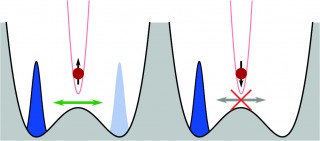Quantum tunnelling is one of the weirdest effects predicted by quantum mechanics: Even though a moving quantum particle has a lower energy than some potential barrier, it will cross or rather tunnel the barrier anyway. CUI PhD student Johannes M. Schurer of the group of Prof. Peter Schmelcher (Universität Hamburg) in collaboration with experimentalist Dr. Rene Gerritsma of the University of Amsterdam has theoretically investigated the tunnelling dynamics of an atomic Josephson junction in interaction with an ion. In a long-term vision, the investigated system can be used as a building block of a solid-state quantum simulator. The results have been published in Physical Review A. Moreover, the paper has been selected as an Editor’s Suggestion.

Bosonic Josephson junction controlled by a single ion: in dependence of the internal spin state of the ion, the atomic ensemble can either tunnel (left) or it is self-trapped (right). Credit: Johannes Schurer, APS
Quantum tunnelling is a direct consequence of the wave nature of particles at the atomic scale. This feature becomes crucial when the so-called de-Broglie wavelength is comparable to the particle size, as it occurs for atoms cooled at temperatures near the absolute zero. In particular, the tunnelling in a Josephson junction is one of the most striking quantum effects to be observed on a macroscopic scale. It has been studied in superconductors, superfluid helium, and ultra-cold atomic gases. In the latter, the interaction between the particles plays an essential role, leading to the phenomenon of self-trapping. Here atoms are prevented from crossing the barrier because of their repulsive interaction.
The atomic flow through the barrier, however, can also be controlled by means of the interaction between the atoms of the quantum gas and a single trapped ion. In his work Schurer has analysed the correlated dynamics of such a combined atomic system. In this system the atoms are confined in a double well, like an insulating barrier separates electrons in superconducting material. “While the dynamics in the self-trapping regime can be well described by assuming that all atoms are in the same quantum state, the tunnelling regime shows quite rich correlated dynamics, where atoms occupy different single particle states,” Schurer explains.
The scientist succeeded in verifying, that despite such correlations it is possible to devise a protocol for engineering a so-called entangled state between the ion and the quantum gas, as originally proposed by Gerritsma and Dr. Antonio Negretti from Universität Hamburg, and therefore realizing an atomic Schrödinger-like cat state on a mesoscopic scale. Schmelcher: “Importantly, Johannes Schurer has provided a feasible strategy to experimentally measure such correlations, paving the way to observe in the laboratory beyond mean-field effects.”
Citation:
J. M. Schurer, R. Gerritsma, P. Schmelcher, and A. Negretti
„Impact of many-body correlations on the dynamics of an ion-controlled bosonic Josephson junction“
Phys. Rev. A 93, 063602 (2016), Editors Suggestion
DOI:10.1103/PhysRevA.93.063602

